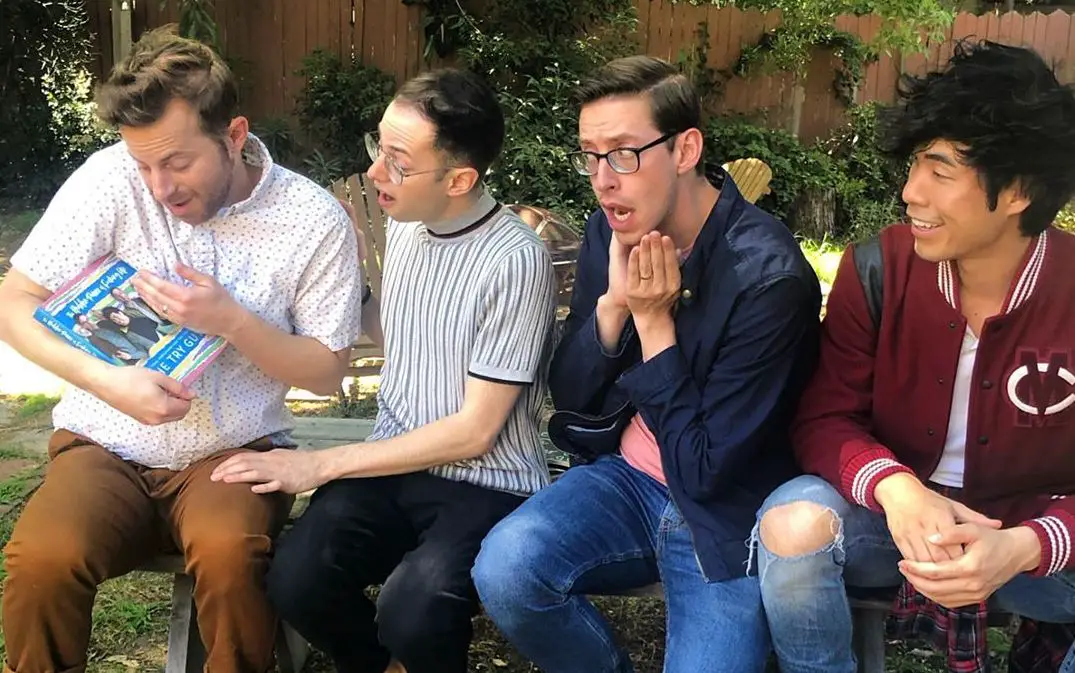It’s been quite a year for Keith Habersberger, Eugene Lee Yang, Zach Kornfeld and Ned Fulmer — better known as comedy stars The Try Guys. After leaving BuzzFeed and starting their own production company, many fans were dying to see where the quartet would land next. As of this summer, they’ve celebrated their first anniversary as an independent company, embarked on a U.S. tour and, most recently, released a book titled “The Hidden Power of F*cking Up.”
The Try Guys tackle their biggest insecurities head-on in the book, taking readers along for the ride on their journey of self-improvement. The book is divided into five main sections: health, style, work, love and family. Each chapter corresponds to one member of the group who wants to improve the most in that area. Even though most of the content within each chapter focuses on one Try Guy, the other three throw in additional commentary and share how they could also evolve and better themselves in that area.
As their name suggests, The Try Guys might not always succeed but will always try something regardless of how scary it might be. Their “failosophy” that they detail in the book encourages rewarding failure and considering it a step forward instead of a step back. Through the duration of “The Hidden Power of F*cking Up,” the guys try the tasks that are most daunting to them individually. They support each other by taking on additional attempts throughout their journey to better themselves and not being afraid to fail along the way.
When you’re balancing school, work, internships and a social life, health can be one of the last things on your mind. The Try Guys are no different. They detail some of the abysmal eating and workout (or lack thereof) habits they had before they decided to do a health and fitness overhaul for the first section of the book.
The health chapter revolves around Habersberger, who is famous in Try Guys videos for being the guy who will eat anything — especially his favorite food, fried chicken. Recently married, Habersberger details the realization that he wants to be there for his wife and future kids for years to come, and decides to make the transition to living a healthier life.
In an age of diet pills and detoxes, some fitness gurus make it seem like undergoing a diet and workout change will fix your problems overnight, but Habersberger is open about the hardships throughout his journey. It’s nice to see him treat it like it is — something hard that you’ll inevitably mess up at times, but not as difficult and scary as you might think. As the Try Guys reinforce throughout the book, you can’t treat failures as something inherently bad; they are something that is necessary for improving yourself in the long-run.
“Queer Eye,” who? The next chapter of the book focuses on new dad Fulmer’s journey to branch out from his classic polo shirt and jeans look. With the help of a stylist, he tries five outfits ranging from slightly outside of his ordinary style to so far out of his comfort zone that he ends up dressing the same as Yang, the most adventurous dresser of the bunch. The pictures in the book documenting Fulmer’s fashion journey add a rather hilarious visual element to his own commentary, especially for someone who was originally too nervous to wear a denim jacket in the beginning of the book.
Fulmer constantly emphasizes that clothes aren’t everything, but they still reflect a certain image of ourselves. I’m glad he made this distinction and clarified that he didn’t completely redo his closet to include all the extreme pieces that he wore throughout the week. Setting realistic goals over time is a recurring theme throughout the book — something that other books of this nature sometimes leave out. Although Fulmer wanted to project a more professional image than before, he lets readers know that you don’t have to completely go to the opposite end of the fashion spectrum and revamp your closet to reflect who you actually are.
After turning their love of making silly YouTube videos into a full-blown LLC, the Try Guys have plenty of valuable insight to share about their work life and achieving work-related goals in the next chapter. They discuss topics like establishing the right work-life balance, combating burnout and being blunt about how sometimes they still fail at that. Their commentary, though slightly sad at times, is much needed, especially in an age where more digital content creating jobs are becoming the norm and adults are becoming burnt out quickly.
The Try Guys aren’t the first YouTubers to publish a book about their failures and triumphs. I would say that they’re some of the few who have gone from YouTubers to businessmen, hiring an entire staff to help them continue to create content after their stint at BuzzFeed. Even though they have much to celebrate now, they’re brutally honest about the hard parts of holding the fate of their employees in their hands and keeping themselves afloat at the same time.
Being able to open up about the hardships and the less glamorous side of creating digital content makes the book more authentic. Many content creators on platforms like YouTube and Instagram present the image to their followers that they live carefree lives full of creating content and having fun with their endless amounts of YouTube money. That might be the case for some, but it’s refreshing that The Try Guys don’t shy away from the fact that they struggle the same way many of us do in our work lives.
Would this really be a semi-self-help book without talking about romantic relationships and self-confidence? The next chapter in “The Hidden Power of F*cking Up” feels cliche at times, although all the guys are mostly self-aware of that in their own commentary (Fulmer is infamous in their videos for constantly mentioning his wife). Even among some of the cheesy bits, the stories of the guys meeting and newly dating their significant others are hilarious and heartwarming.
Perhaps the most important part of this chapter is Yang’s perspective of being a queer person of color and how those parts of his identity shaped his perception of love. Although the other three guys have interesting stories to tell, Yang’s is one that’s familiar to other queer kids but rarely talked about on such a large platform. I really appreciated how vulnerable he gets in his section of the love chapter, regardless of how much he claims to hate vulnerability as demonstrated by the family chapter.
The final full chapter jumps straight into something that can still be relatively taboo — family. Rocky familial relationships can be hard to talk about, especially when those around you seem to be living the opposite experience. This chapter might be the most moving, as it focuses on Yang’s struggle as a queer child of divorced Korean immigrants to find a way to meaningfully connect with his extended family.
Out of all the issues discussed in the book, having a skewed family dynamic is probably the most common. Yang’s situation is a personal one for many, and you can tell he’s dedicated to trying to turn it around regardless of how uncomfortable it makes him. Although he doesn’t totally succeed in all his goals, he recognizes that letting his guard down around his family takes time and that he is still actively trying, which is always a success in The Try Guys’ book (pun intended).
“The Hidden Power of F*cking Up” is, overall, a sweet and insightful read. The road to self-improvement doesn’t seem entirely impossible when four regular guys lay out the groundwork for you and make messing up seem a little less scary. Even if you can’t relate exactly to some of the situations the guys describe in the book, there are tips for self-improvement they share that we can all adopt in our everyday lives.
Diehard fans and people who have never even heard of them alike – we could all stand to benefit from learning a thing or two about the real hidden power of f*cking up with grace from these guys.
















